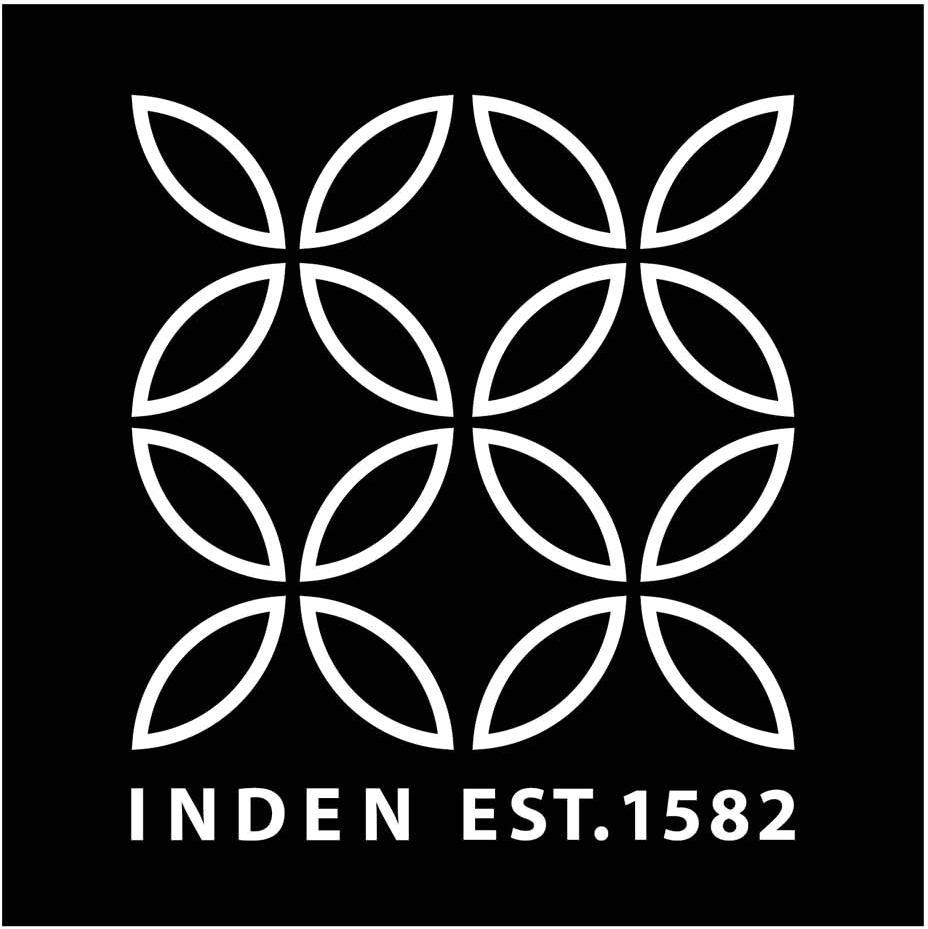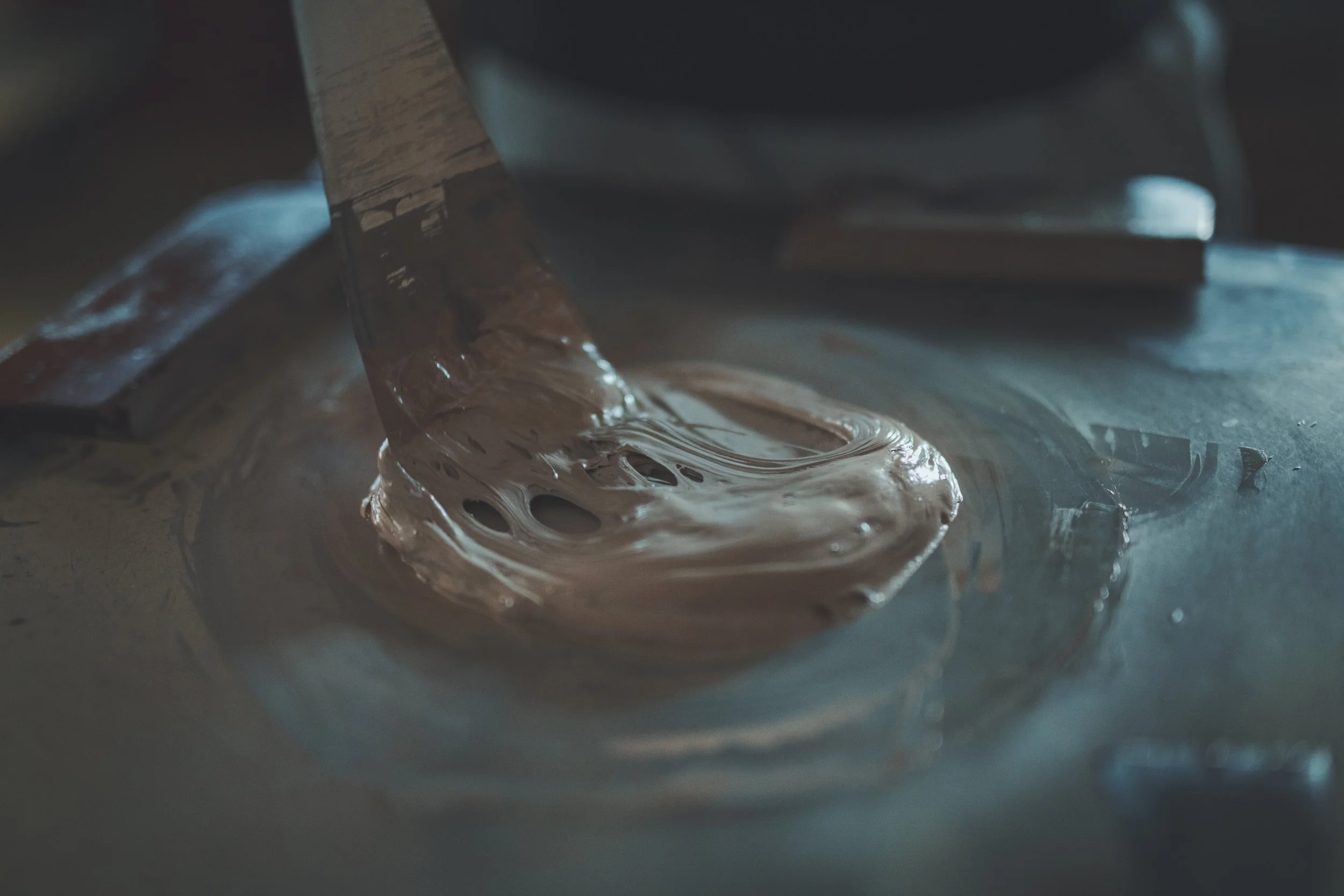Mikio Omori
INDEN est.1582 Lacquer Artisan
-Lacquering-
Unique style and patterns with lacquering.
When it comes to INDEN, what comes to mind is the unique process of lacquering deerskin. Lacquering is one of the most important techniques used in creating INDEN accessories. Carved patterns are placed by hand on dyed deerskin, and the patterns are created by brushing lacquer onto it. At INDEN est.1582, all products are designed with this lacquering technique, which gives products a unique shine and a sense of luxury that is even more pronounced. We interviewed Mr. Omori, who oversees all aspects of lacquer production, including the attractiveness of lacquer, what made him decide to become a lacquer craftsman, and his vision for the future.
What inspired you to become a Lacquering craftsman?
Mr. Omori is a craftsman from Yamanashi. After graduating from a university in Tokyo, he tried to find a job at a general office company, but working as an office worker was not quite the right fit for him. While he was figuring out his next move, he randomly saw a TV show about a potter’s history and was fascinated by the ways of manufacturing. Here, his journey began.
Since he was a child, Mr. Omori love to build plastic models and radio-controlled cars. He realized that he desired to work with handicrafts, and he happened to find a job opening at INDEN, a traditional craft in his hometown of Yamanashi Prefecture. Knowing that INDEN only opens positions for artisans rarely, he took this as a sign of destiny and began his journey with INDEN to become a master artisan.
Lacquer has lived in harmony with humans since Ancient times
Lacquer is the sap that oozes from trees and as such has superior adhesiveness and waterproof properties. It has long been used for crafts and cultural assets and you can trace its use back to ancient times. INDEN uses its tried and true nature to its advantage, mixing it with to create the patterns loved on its accessories. The color and hardness of the lacquer is adjusted depends on the humidity and temperature on the day, as well as the pigment content, as perceived by the craftsman.
Working at Inden and tradition
After joining the company, he was assigned to the lacquer department because he strongly desired to be involved in the lacquering process that so deeply represents INDEN. Since then, Mr. Omori has devoted the past 25 years to learning and perfecting the process.
The lacquering process
The patterned lacquer is placed in a Muro (room) with a constant temperature and high humidity, drying for at least two days. Mr. Omori is responsible for maintaining the Muro (room) including regulating the temperature and humidity and adjusting for factors like weather. Since lacquer is a natural product, its properties can change over seasons and Lacquer has different qualities every year, and it can become stronger or more docile, however, Mr. Omori is able to hear Lacquer's voice to handle it well and act according to circumstances.
The deerskin and lacquer used by INDEN are all natural products. Lacquer professionals require the skills to adapt to every environment because the lacquer is easily changed due to the weather, humidity, and all other environmental factors. To maintain quality, INDEN draws on its centuries old expertise to remain flexible and adaptable ensuring that quality is never compromised.
Surprisingly, Mr. Omori says that he is not so focused on the “tradition”. He believes innovation and change is necessary to continuing to create the most quality product.
The technique of INDEN has been evolving since ancient times. In the Edo period, lacquer was mostly used for the purpose of water repellency. It later evolved into the fashion accessory we know today. Thus, craftsmen have always had to adapt and change to generate new products that meet the needs of the times.
“400 years is quite a long if you see only the number. However, the most important thing is how to take over this legacy for the next generation rather than how long did we have the history. “ Mr. Omori thinks. In Yamanashi Prefecture, when you go to a supermarket, you can see somebody carrying INDEN items. INDEN has produced the daily life items, and INDEN has adapted to the changing times and reading the social needs of people's lives; that's why INDEN can blend naturally into daily life. INDEN has become a part of people's daily lives as a slightly luxurious daily necessity rather than a special craft.
Craftsmanship and their Spatula
Craftsmen who create hundreds to thousands of lacquer leather goods use their spatula for 20 ~ 30 years. This tool is integral to the process and so tailored to each craftsman that it often spatula changes its shape to match the craftsman's finger shapes over time.
The difficulty of Lacquering Technique
Even Mr.Omori had a hard time applying lacquer for the first time. The lacquer splattered everywhere and stuck on his hands, and he struggled to handle the process. At first, he learned the lacquering process by trial and error. After practicing with various types of lacquer and patterns, he was finally able to produce a sellable product. The lacquering skill can be learned in 4-5years‘ training but can take much longer to intuitively get a feel for it. Learning how to use the spatula, is often not by logic, but by doing it enough times that the method becomes familiar to your body. Handling lacquer is the most difficult piece because the lacquer can quickly change colors or dry depending on the humidity and temperature — which constantly fluctuates.
In Summer, the humidity high and the lacquer quickly dries but in Winter, the lacquer may take longer. Mr. Omori is an expert in handling those stubborn lacquer‘s requirements. It is difficult to maintain optimal conditions using only the thermometer as a guide, so artisans have to also rely on intuition. The most essential piece of producing good products is expanding these sensibilities.
Even after 25 years, Mr. Omori still views himself as in training and often feels there are only a few days a week where he does a perfect job. “We work with the mind that we are in tune with the lacquer. Lacquer is made from sap, so we work like we are handling a living creature.” he said. You'll get it by practicing everyday for 4-5 years, but it is difficult to say, "Yes, I can create satisfying products every time." We are working through trial and error every time. Every INDEN item is created by hand and producing hundreds of high-quality products can be nervewracking.
Moments that made him happy in his 20 years as a craftsman
It is impossible to lacquer 100~1,000 pieces of lacquer a day, from small to large size, without making a single mistake. Since the lacquer is painstakingly made by a professional's hands, not by machine, it is normal for a few pieces to fail. However, there are rare days when I don't make a single mistake and have a perfect day. On such days, "It feels great!"
The charm of INDEN that Omori craftsman thinks
INDEN really has a wide variety of products, patterns, and colors. This variety is what Mr. Omori thinks is the most attractive piece of INDEN. Although the techniques used (Sarasa, Fusube, and Lacquer) are completely different, they can all make the same INDEN product. There are 200 or 300 types of patterns and colors, including combinations of Sarasa x Fusube or Lacquer x Sarasa, and Single Fusube products. We can actualize a wide range and abundance of variations because we produce all items by hand, not by mass production.
Craftsman Omori’s Best Yamanashi Spot
Mr. Omori loves to be outdoors, and has been cycling for more than a decade now. Recently, he has been participating in races as well. He prefers a cyclo-cross race, which is held only in winter. This type of racing requires him to ride his road bike off-road on a course built in a park or on a riverbed. He is also into stair-climbing and mud-covered races, and he participates in it every season.
He recommends stopping by the INDEN Museum to
see the craftsmanship for yourself after participating in the cyclocross!






